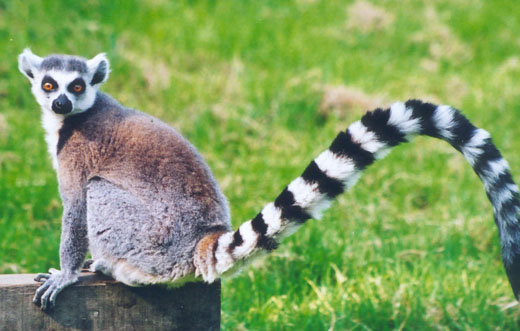All
of these primates really mostly on vision for finding food as opposed to
olfaction. They all have their eyes on the front of their face; this allows
them to be able to have color vision and stereoscopic vision (Depth
perception).
Lemur:
There environment,
they at one point lived in tropical areas of the earth but today they are only
found in Europe, Asia, and Africa. Some species are only arboreal and other
larger species spend half there time in trees and the other half on the ground.
Their body size, they
range in sizes from a small to a large domestic cat.
Sexual Dimorphism:
males usually increase in body mass and testes by 100% before mating season.
Primate traits in environment: The male’s lemur has to compete with other males for a mate so there
body mass increases because of competition. They are herbivorous so there sense
of smell is increased compared to other primate’s maybe so they are better able
to find fruits.
Chimpanzee:
Our closest
relatives
There environment: Because
of deforestation chimpanzees live in patches of what’s left over of
rainforests. They are mostly found on the equatorial belt from the Atlantic
Ocean to Lake Tangayika but can also be found in
bamboo forest, swamp forests, and the savanna area because they are very
adaptive. They spend a lot of their time in trees where they sleep eat and hang
out.
Their body size: They
can grow to be 4 to 5.5 ft and weigh from 70 to 150 pounds.
Sexual Dimorphism: Females
reach reproductive age at 13 while males are not adults till they are 16. There
sexual dimorphism is not as pronounced as other primates, with males weighing
about 150 pounds and females 100 pounds.
Traits in environment:
Chimpanzees live in forest areas where they are able to find fruits, seeds, and
insects that their diets consist most of.
Baboons:
There environment: All
baboon species live in Africa or Arabia. They
usually prefer to live in the savannah and some live in tropical forests.
Their body size: They
can grow from 50 to 100 pounds and their bodies are twenty to forty inches
long. They all have long muzzles and heavy powerful jaws.
Sexual Dimorphism: Baboons
have strong sexual dimorphism males are bigger than females, bigger canines,
and males also have a mane. Sometimes male and female baboons are different
colors as well.
Traits in environment: Baboons
spend much of their time on the ground but go up into trees to sleep, eat, or
be on the look out. They eat just about anything they can get their hands. They
are sometimes considered pests because they eat farmer’s crops!
Gibbons
Their environment: Gibbons
are strictly arboreal and live in the dense forest of southern Asia. There are species that are found ranging from
northeaster India to
southern China.
Their body size: Gibbons
weigh from nine to twenty nine pounds and grow from 17inches to 25inches.
Sexual Dimorphism: Males
and females are very similar. Some gibbons show sexual dimorphism through the
color of their fur. Both the males and female are very territorial and defend
their territory with whoops and songs. Males are very involved in taking care
of their child. My boyfriend can learn a thing from them.
Traits in environment: Because
Gibbons spend most of their time in trees they are the most knows for their
acrobatic brachiating. They feed mostly on fruits, their favorite being figs!
What I thought was very cool was the gibbons have a ball and socket joint in
there wrist. This allows them to use less energy because they don’t have to
move as much.
Spider Monkey
Their environment: Spider
monkeys live in Central, South America and Mexico. They live primarily in
evergreen rainforest but also inhabit semi deciduous and mangrove forest.
Their body size: They
grow from fourteen to twenty-six inches and weigh from 13 to 25 pounds.
Sexual Dimorphism: Males
sexually mature at five and females at 4. There born black as babies and as
pre-adults change color. Females give birth to one baby every 2 to 4 years.
Sexual dimorphism is not very prominent with just the males being slightly
larger.
Traits in environment: Adoptions
to their environment is that they do not have opposable thumbs because they do
not need them to move about trees. They also have a tail that grips and they
can also use to move from branches. They live in trees because they eat mostly
fruits and seeds.
Over
all I have found that the diet of all primates is mostly the same. They all eat
fruits and seeds with some that also eat insects and small mammals. They live
in almost the same type of environment, mostly tropical with lost of trees and
plants. Because they live where there are so many trees some have adapted to
living mostly in the trees where they are safe from predators and are able to
find more fruits. They all had opposable thumbs that they use for picking at
insects except for the spider monkey that has evolved without them to be able
to swing form trees better and for this reason also has evolved a tail with
griping pads.
Sources:
http://www.janegoodall.org







